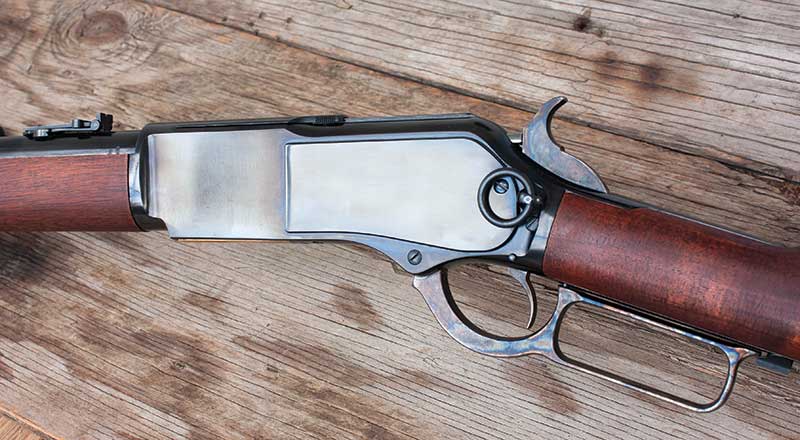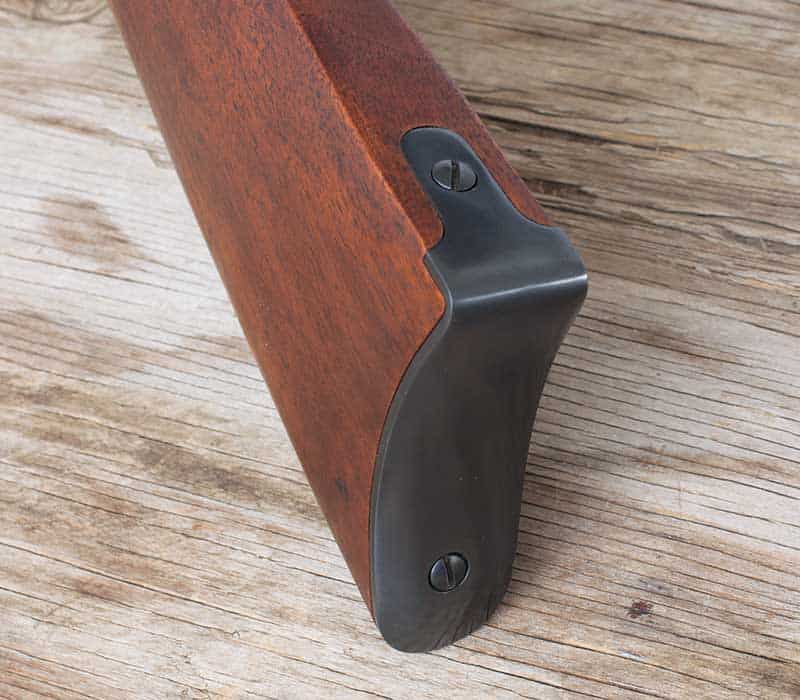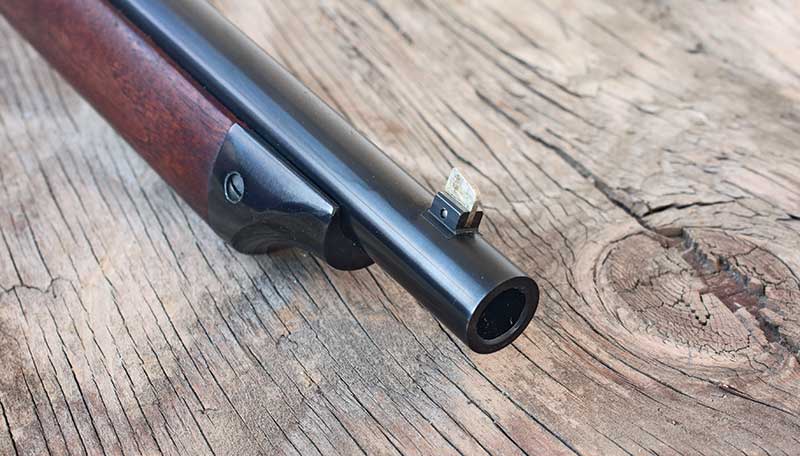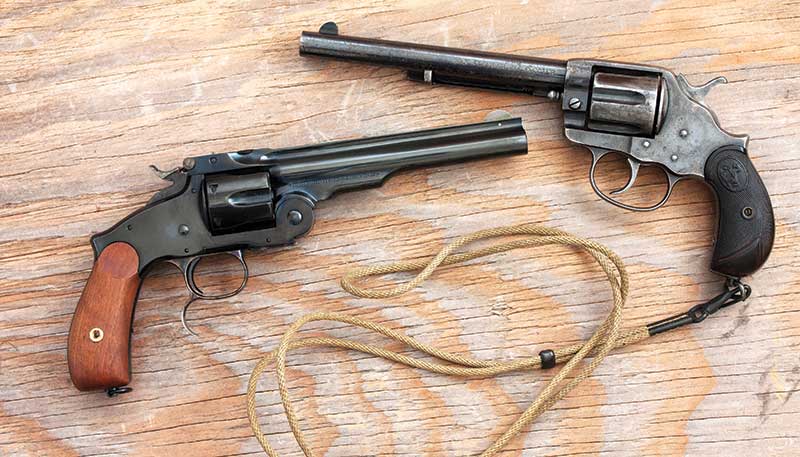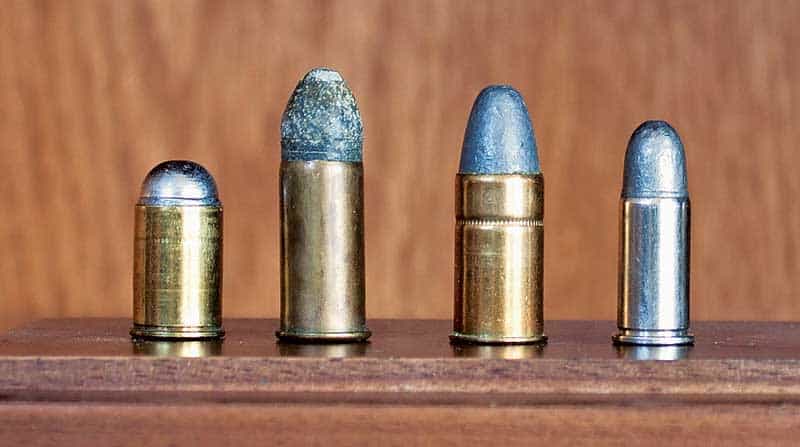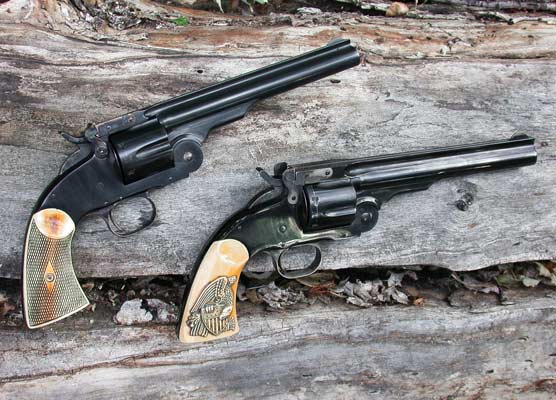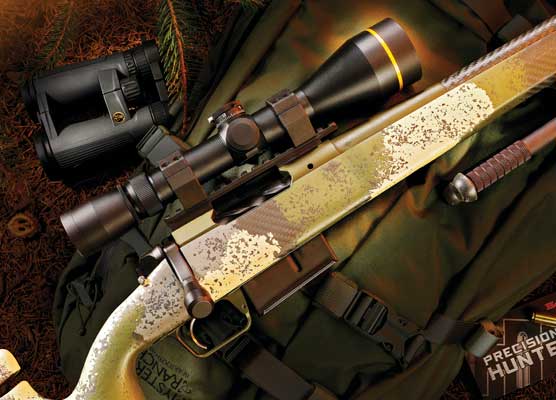Guns Of The Scarlet Riders
Outfitting A 19th Century Mountie With Current Reproductions Calls For A Bit Of Research. Not To Mention A Bit Of Rangework!
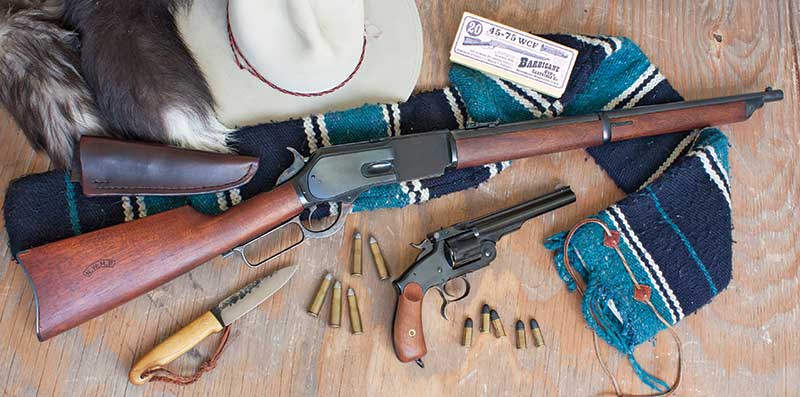
The North-West Mounted Police quickly discovered the scarlet British uniform and pith helmet to be useless on the
frontier. The force quickly adopted Stetson hats and buckskins for patrol. Improving their firepower greatly was the
adoption of the 8-shot Model 1876 Winchester in .45-75 WCF. The unsuitable .450 Mk I Adams cartridge conversion
revolvers were supplemented by .44 Russian S&W No. 3 revolvers prior to the adoption of the Enfield Mk II.
There is a romantic allure to Winchester’s 1876 North-West Mounted Police carbine, which armed the Scarlet Riders for several decades during the turbulent late-19th century. The adoption of the ’76 by the NWMP was a necessary move, and the force simply purchased the most powerful repeating rifle readily available to them at the time.
After the Custer Massacre in 1876, the Sioux crossed the border into Canada and were well-armed with repeating rifles themselves. In addition, the NWMP had to contend with well-armed smugglers and whiskey runners as well. The Mounties realized how woefully under-armed they were with the already obsolete single-shot Snider carbines and Adams revolvers, both of which had been converted from percussion to cartridge.
The fact that Britain was still armed with single-shot rifles—combined with how small the NWMP was—caused the force to take a hard look at the repeaters then available to even the odds. They ultimately set their sights on the .45-75 Winchester Model 1876 Carbine and purchased 50 from a retailer for trials in 1878. The carbines would give the NWMP a ballistic advantage over the Henry, Spencer, 1866 and 1873 rifles popular among Indians and smugglers.
The first 50 trial carbines had a simple “non-adjustable leaf sight” and no dust cover. The force requested improvements, and the most important of which was increasing the barrel shank diameter to give the barrel/receiver joint greater strength. The next 50 also had a dust cover and an improved adjustable leaf sight. However, the new rear sight still proved inadequate, and a military-style sight called the “Spanish Meter” sight (because it was first used on Winchesters provided to the Spanish government) was ordered. The force eventually purchased 1,611 Winchester 1876 carbines.
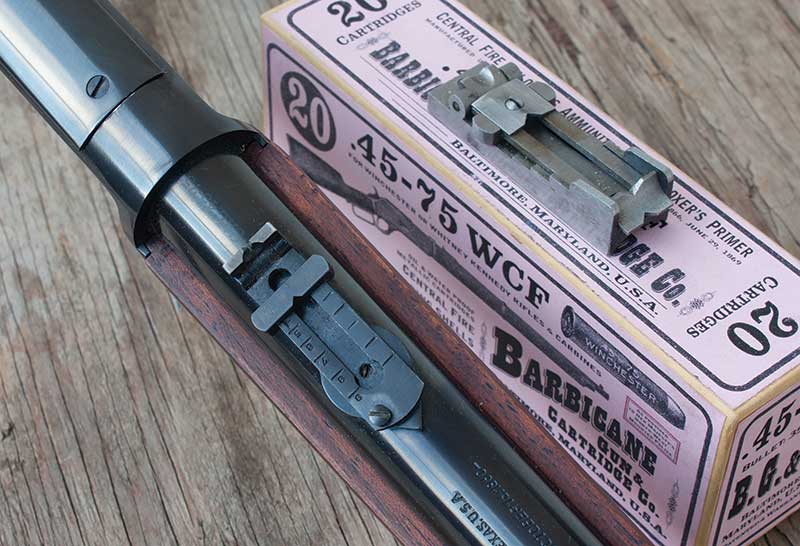
Early Winchesters acquired by the NWMP had standard carbine sights dovetailed into the barrel (top).
Later, the sturdier “Spanish Meter” rear sight (shown in the white) were ordered. It was attached with two
screws. The front sight (bottom) is dovetailed into the barrel, while original Winchesters had the sight sweated
on. The useless nub of the Uberti was milled off and a 0.063-inch German silver blade pinned in place.
Cimarron Steps In
Upon seeing the first Cimarron 1876 rifle in .45-60, I had hoped a carbine would eventually enter the catalog, since it is one of the more exotic-looking arms of the Old West. I was even happier to find Cimarron would reproduce the gun from the second lot of 50 guns, which was provided to the force featuring the carbine sight, dustcover, NWMP markings and most importantly, was chambered in the original .45-75. I had mine shipped to Holt Bodinson, who wrote about it in the December 2010 issue (www.gunsmagazine.com/digital-editions).
Components for some of the odder calibers remained in supply during the “Great ObamaScare Ammo, Gun and Component Shortage” of the last few years, and I was able to acquire dies, mold and 150 rounds of rather expensive, new, high-quality Jamison brass. The carbine required tuning to shoot well, but once I was satisfied with its performance at the range, I realized I wouldn’t really be living until I had the appropriate NWMP companion handgun from the same time period as well.
The handguns issued to the NWMP in 1874 were old .450 Adams Mk I cartridge conversions and, later in the 1880’s, the odd-looking .476 Enfield Mk II. Originals of either are pricey, with NWMP specimens quite scarce, since so many were used up. I perused the book Arms and Accouterments of the Mounted Police 1873-1973 by Philips and Klancher, to aid me in my search for a suitable—and current—repro handgun. It proved to be Uberti’s copy of the S&W Old Model No. 3 Russian.
Initially, many of the NWMP’s Adams Mk I’s were so poorly converted, the British War Department agreed to exchange them. In the interim, the force purchased 30 S&W No. 3 Old Model .44 Russian revolvers, one of which history records as still in service during 1878. Truth be told, individual troops purchased a wide variety of American-made arms such as the Colt SAA and 1878 DA revolvers among others, so a Colt (or Colt clone) would have been equally correct as well. But in the Old Model Russian’s favor was the fact it was an issue revolver. None of the original 30 S&W revolvers are known to have survived, and if they had ownership marks peculiar to the NWMP, those markings are lost to history.
When I was hit by the “have-to-have-fever,” the supply of No. 3 revolvers dried up as ObamaScare II swept the nation. I haunted the Internet for one, and balked at the retail-plus prices asked. So I waited until they made more.
The overall fit and finish of this No. 3 Russian Top Break (its official name) is superb. The bluing is rich and deep, and metal polish is very good, with no ripples in the rather complex contours of the barrel and frame. The grips have a nice matte oil finish, unlike the slippery wood finish found on most of the Uberti arms. The case hardening on the hammer barrel-locking block and triggerguard is very attractive.
A nice touch is the finish on the screws and pins. They all fit perfectly and the screws passing through the frame are correctly trimmed and the ends domed. No threads appear—just the domed end of the screw. The pins are as well finished on both sides. And the sideplate fit is exceptional.

The 5-shot Mk I Adams cartridge conversions proved disappointing in service, although some officers purchased
the 6-shot Mk II (shown) and Mk III Adams revolvers privately. The .450 Adams was one of the more anemic military
rounds fielded in the 19th century. Photo courtesy: www.rockislandauction.com.
The serial number is visibly stamped on the frame, face of the cylinder and under the locking block. The barrel address is marked in Cyrillic letters—as were the ones shipped to Russia in the 1870’s.
Oddly enough, although the revolver is marked “.44 Russian,” it is chambered in .44 Special (I checked with John Taffin and Duke Venturino and their older Uberti’s are chambered for the shorter Russian round). But the .44 Special chambering wasn’t a deal breaker for me. In fact, it increases the utility of the revolver, since it is usually easier to get Specials. They are not supposed to be chambered for Specials, so be sure and decide if it is important to you. The cylinder length is long enough for this model to be chambered in .45 Colt (another current option).
Be advised, even if it chambers .44 Special these top-break revolvers should only be fired with ammunition loaded to SAMMI specifications and never with any of the hot-rodded +P loads available. The Uberti is well made from modern materials, but a top break can’t compare in strength to a solid-frame revolver. On the plus side, if you want to duplicate black-powder .44 Russian loads, the Special case is ideal, since it has the capacity of the old balloon-head Russian cases. This is not the case with the newer solid-head Russian brass.
I went to the range with my .44 Russian handloads along with some Black Hills and Winchester factory ammo. The Black Hills, topped with a 210-grain bullet, was certainly adequate for Cowboy Action shooting, delivering 25-yard groups in the 3-1/2-inch range. Switching to a handload using a 246-grain lead roundnose over 3.8 grains of TiteGroup delivered one ragged hole at 15 yards and 2-1/2 inches at 25 yards. Winchester factory .44 Special 246-grain lead RN’s delivered the best 25-yard group of 2-1/4 inches.
The 7-pound trigger pull had creep on top of being heavy. A trigger job is in order, but won’t be as easy as with Colt-style revolvers, since many of the components are pinned in place. Another thing, the sights need to be corrected for both windage and elevation.
My Cimarron NWMP carbine had some accuracy problems, most notably throwing shots 3, 4 and 5 wide, although the first two would be close together.
It also shot very high at 50 yards. The good news was the action was smooth, the trigger light and creep-free, and the lever safety spring not too heavy.
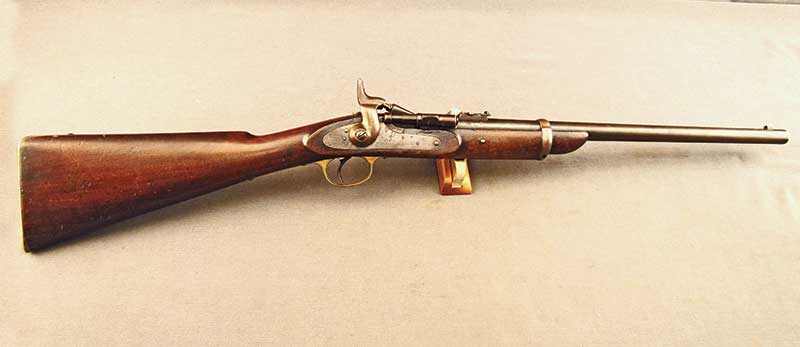
The slow rate-of-fire possessed by the Snider carbine issued to the force early on meant the NWMP was hopelessly
outclassed by opponent’s repeating rifles. Canadian-issue Sniders such as this one are marked “DC” on the left side
of the butt. Photo courtesy: www.joesalter.com,
(603) 732-4000.

The NWMP was faced with Indians and smugglers armed with a wide variety of arms including such as the
.56-56 Spencer (above, far left), big long-range single shots (.40-70 Ballard shown middle left), as well as
repeaters in .44-40 (left). While formidable looking, the .577 Snider (far right) was already obsolete. Adoption
of the .45-75 WCF (middle right) gave the force a powerful repeating round capable of challenging both man
and beast on the frontier. Handgun cartridges used by the NWMP included (below, left to right) .450 Adams,
.44 Russian, .455 Mk II, and later, towards the turn of the century, the .38 S&W for plainclothes officers
armed with S&W New Departure pocket revolvers.
After rereading M. L. McPherson’s chapters on lever actions in Accurizing the Factory Rifle, I discovered the fore-end was bearing hard both at the receiver face and fore-end lug. The mag tube also was jammed into place between the receiver and the lug dovetailed into the bottom of the barrel for the nose cap. The nose cap was tightly fitted to the barrel and forced against the wood so hard I was afraid I was going to twist the head off the retaining screw while removing it. The barrel band was “squish fit” tightly to the wood and barrel. None of these attributes contribute to accuracy.
Per McPherson, I relieved just enough of the mag tube to give it a little fore-and-aft play and polished the end entering the receiver. Next I scraped away the wood on the end of the fore-end where it touched the face of the receiver. I then used a Dremel to grind away a little off the nose cap where it touched the barrel. Lastly, I relieved the barrel band on the area in contact with the barrel until a thin piece of paper would slide in between band and the barrel.
I loaded up 20 rounds of ammo using Hodgdon Trail Boss and a 350-grain bullet cast from the correctly-profiled Buffalo Arms mold. Now I got a 5-shot group at 50 yards in the 3-inch range (still too high), and had an epiphany. The finish on the stock was so slippery I couldn’t maintain a consistent hold very well.
I next stripped and refinished the stock. Uberti stocks are finish-sanded closely to the metal and the finish on the stock itself is glass-hard and so thick sanding would remove too much wood. Few strippers touch this finish but Certi Strip from Brownells will. Steel wool barely touches this finish even after it is bubbling up (it’s that thick). I employed a sheet of brass to scrape off the finish.
The wood underneath the metal had no finish and I tested stains there until I achieved the color I wanted. I used Pilkington Oil Finish over the stain and, when I was satisfied, brushed in a generous coat of Laurel Mountain Permalyn Sealer. Now the rifle felt like it was rosined to my hands.
This 1876 has a standard Winchester-style carbine sight with a V-notch combined with a front sight on a block with the blade ground so fine it appears to be an inverted-V front (I prefer a square-blade front with a V-notch rear).
Track of the Wolf offers a variety of German silver sights and sheets in various thicknesses, from 0.050-inch to 0.080-inch. Rather than buy a sheet, it was far cheaper to buy a front sight and loot the blade. Friend Roger, who runs the “Biggest Little Gunshop in Reno,” milled the useless inverted “V” off the sight block, slotted it and installed a 0.063-inch blade, pinned through the sight block. The 0.063-inch width proved perfect for the V-notch rear.

One way to get a little more shooting done with black powder is topping the case with jacketed bullets (above).
The Hornady 350-grain bullets delivered this nice 5-shot group at 50 yards. As with many originals, the Uberti No. 3
Russian shoots very high at 25 yards (below), yet is quite accurate. Fit and finish of the top-break repro is superlative.
Finding a Load
The toggle-link action of the 1876 Centennial is not strong, and smokeless-powder loads won’t safely approach the power of original black powder loads. The light-for-caliber bullets don’t generate enough resistance for the black powder to burn completely, quickly fouling the shallow rifling. Modern solid-head brass doesn’t hold enough black powder to reach original ballistics, either. Still, to get that pleasant boom and a large puff of smoke, I shoot jacketed bullets over black powder (a tip from Duke Venturino.) I can shoot a full magazine or two with decent accuracy without cleaning, since the jacketed bullets scour the black powder fouling with each shot. Initial 5-shot groups are very good, and I wouldn’t hesitate to hunt with this gun.
I found 4 boxes of previously-owned Hornady .458 350-grain jacketed softnose bullets very reasonably priced at a gun show. Loading 20 rounds with the Hornady bullets over 62 grains of Goex FFg in Jamison brass, I headed off to the range and shot a 5-round, 50-yard group 2 inches high and an inch wide. Cutting the sight, I returned to the range, moved the target out to 100 yards and shot a 4-shot group of 2-1/2 inches, with shot 5 pulling out the group to 4-1/2 inches.
I charged the cases through a drop tube and seated the bullet to just touch the powder. The Hornady bullets sat below the cannelure and no roll crimp could be applied. Not a big deal, since the bullet is sitting on the powder, but this technique precludes using smokeless powder since recoil will cause the bullets to telescope in the magazine.
Switching to Speer 300-grain “Plinkers,” proved a better bet as they can be crimped into the top of the cannelure. The Speer 350-grain bullets begin to taper before they are deep enough, and the brass has to be rolled over the nose—not a big deal, just harder on brass life, and won’t work with smokeless powder.
Cast bullets over Trail Boss were accurate and fun to shoot. They delivered a little higher velocity than I expected—higher than the jacketed bullet loads—and I may just settle on them for the majority of my fun shooting.
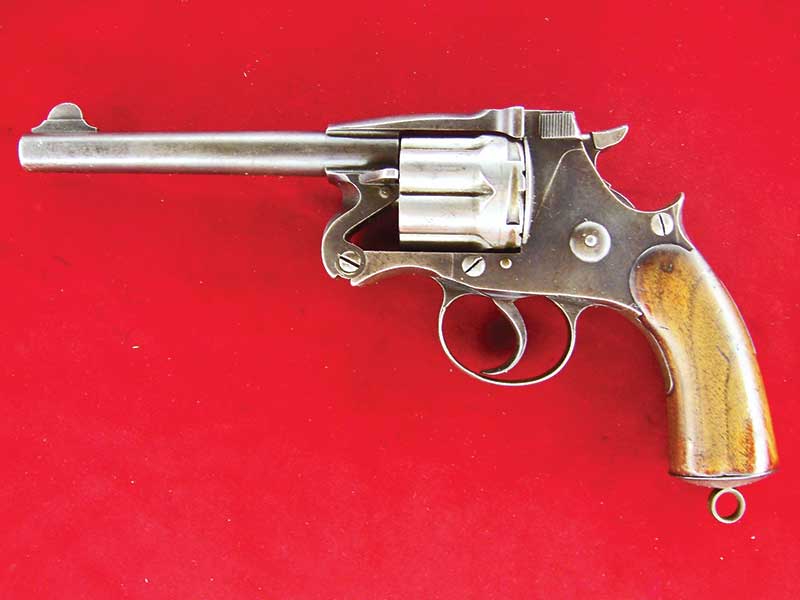
The robust and odd-looking Enfield Mk II in .476 was adopted by the force in the 1880’s and served into the
20th century. A top-break, the cylinder slides straight ahead to eject the spent casings. After unloading, the
revolver was closed and charged through a loading gate one at a time. It was both a cumbersome and heavy
revolver. Photo courtesy: www.handgunsoftheworld.com.
The Final Factor
To me, one of the allures in our hobby is the romance associated with an arm. Having the M1876 carbine and a handgun known to be issued to the Scarlet Riders increases the fun factor for me. I was hoping to have a belt and holster for the story, but the buckle is on backorder. Always something to look forward to!
.44 Russian & Special Factory Ammo Performance
| Load | Velocity | Group Size |
| (brand, bullet weight, type) | (fps) | (inches) |
| Black Hills 210 FN (Russian) | 697 | 3-1/4 |
| Black Hills 210 FN (Special) | 655 | 3-1/2 |
| Winchester 246 RN (Special) | 727 | 2-1/4 |
Notes: Groups the product of 5 shots at 25 yards.
Magneto Speed chronograph used at the muzzle.
.44 Russian Handloaded Ammo Performance
| Bullet | Powder | Charge | Velocity | Group Size |
| (brand, bullet weight, type) | (brand) | (grains weight) | (fps) | (inches) |
| Remington 246 RN | TiteGroup | 3.8 | 643 | 2-1/2 |
| Cast 265 RN | Swiss FFg | 19 | * | 3-1/4 |
Notes: Groups the product of 5 shots at 25 yards. Magneto Speed chronograph used at the
muzzle. Winchester primers used in Starline brass. *Magneto Speed Chrono can’t pick
up cast bullets over black powder.
.45-75 WCF Handloaded Ammo Performance
| Bullet | Powder | Charge | Velocity | Group Size |
| (brand, bullet weight, type) | (brand) | (grains weight) | (fps) | (inches) |
| Buffalo Arms .458 350 Cast | Trail Boss | 17.6 | 1,268 | 2-1/2 |
| Hornady 350 FN | Goex FFg | 62.0 | 1,068 | 4-1/2* |
| Speer 300 Plinker | Goex FFg | 64.0 | 1,217 | 2 |
| Speer 350 FP | Goex FFg | 60.0 | 1,155 | 2-3/4 |
Notes: Groups the product of 5 shots at 50 yards. Magneto Speed chronograph used
at the muzzle. Winchester primers used in Jamison brass. *100-yard group.
No. 3 Russian Top Break
Maker: Uberti
Brescia, Italy
Importer: Stoeger Industries
17603 Indian Head Hwy
Accokeek, MD 20607
(301) 283-6981
www.uberti.com
Action type: Top break, single action
Caliber: .44 Russian
Capacity: 6
Barrel length: 6-1/2 inches
Overall length: 12 inches
Weight: 45 ounces
Finish: Blue
Sights: Fixed
Model 1876 NWMP carbine
Maker: A. Uberti
Brescia, Italy
Importer: Cimarron Firearms
105 Winding Oak Rd.,
Fredericksburg, TX 78624
(830) 997-9090
www.gunsmagazine.com/indexwww.uberti.com
Action: Lever-action repeater
Caliber: .45-75 WCF
Capacity: 8+1
Barrel length: 22 inches
Sights: 100-900 yard ladder rear, blade front
Weight: 8.5 pounds,
Finish: Blue
Stock: Walnut Price: $1,818.70
Grips: Walnut Price: $1,079
